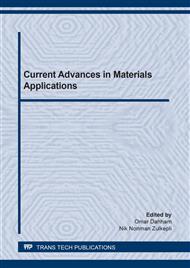[1]
D. Albanese, Liquid–liquid phase transfer catalysis: basic principles and synthetic applications, Cata. Rev.: Sci. and Eng. 45:3-4 (2003) 369-395.
DOI: 10.1081/cr-120025538
Google Scholar
[2]
G. Gokel, W. Weber, Phase transfer catalysis. Part I: General principles, J. Chem. Edu. 55 (1978) 352.
Google Scholar
[3]
A. J. Burke, , C. S. Marques, N. J. Turner, G. J. Hermann, Active Pharmaceutical Ingredients in Synthesis: Catalytic Processes in Research and Development'', first ed., Wiley-VCH Verlag GmbH & Co. KGaA, Weinheim, (2018).
DOI: 10.1002/9783527807253
Google Scholar
[4]
Z. Siddiqui, S. Praveen, T. Musthafa, A. Ahmad, A. Khan, Thermal solvent-free synthesis of chromonyl chalcones, pyrazolines and their in vitro antibacterial, antifungal activities, J. Enzy. Inhib. Med. Chem. 27, (2012) 84-91.
DOI: 10.3109/14756366.2011.577035
Google Scholar
[5]
Z. Nowakowska, A review of anti-infective and anti-inflammatory chalcones, Eur. J. Med. Chem. 42 (2007) 125-137.
DOI: 10.1016/j.ejmech.2006.09.019
Google Scholar
[6]
Y. Lin, Y. Zhou, M. Flavin, L. Zhou, W. Nie, F. Chen, Chalcones and flavonoids as anti-tuberculosis agents, Bioorg. Med. Chem. 10 (2002) 2795-2802.
DOI: 10.1016/s0968-0896(02)00094-9
Google Scholar
[7]
R. Gacche, N. Dhole, S. Kamble, B. Bandgar, In-vitro evaluation of selected chalcones for antioxidant activity, J. Enzyme Inhib. Med. Chem. 23 (2008) 28-31.
DOI: 10.1080/14756360701306370
Google Scholar
[8]
M. Bonesi, M. Loizzo, G. Statti, S. Michel, F. Tillequin, F. Menichini, The synthesis and angiotensin converting enzyme (ACE) inhibitory activity of chalcones and their pyrazole derivatives, Bioorg. Med. Chem. Lett. 20 (2010) 1990-1993.
DOI: 10.1016/j.bmcl.2010.01.113
Google Scholar
[9]
N. Gorobets, B. Yousefi, F. Belaj, C. Kappe, Rapid microwave-assisted solution phase synthesis of substituted 2-pyridone libraries, Tetrahedron. 60 (2004) 8633––8644.
DOI: 10.1016/j.tet.2004.05.100
Google Scholar
[10]
A. Fassihi, D. Abedi, L. Saghaie, R. Sabet, H. Fazeli, G. Bostaki, Synthesis, antimicrobial evaluation and QSAR study of some 3-hydroxypyridine-4-one and 3-hydroxypyran-4-one derivatives, Eur. J. Med. Chem. 44 (2009) 2145–2157.
DOI: 10.1016/j.ejmech.2008.10.022
Google Scholar
[11]
R. Parreira, O. Abrahão, S. Galembeck, Conformational preferences of non-nucleoside HIV-1 reverse transcriptase inhibitors, Tetrahedron. 57 (2001) 3243–3253.
DOI: 10.1016/s0040-4020(01)00193-4
Google Scholar
[12]
P. Dragovich, T. Prins, R. Zhou, E. Brown, F. Maldonado, S. Fuhrman, Structure-based design, synthesis, and biological evaluation of irreversible human rhinovirus 3c protease inhibitors, 6. structure−actvity studies of orally bioavailable, 2-pyridone-containing peptidomimetics, J. Med. Chem. 45 (2002) 1607–1623.
DOI: 10.1021/jm010469k
Google Scholar
[13]
Q. Li, L. Mitscher, L. Shen, The 2-pyridone antibacterial agents: bacterial topoisomerase inhibitors, Med. Res. Rev. 20 (2000) 231–293.
DOI: 10.1002/1098-1128(200007)20:4<231::aid-med1>3.0.co;2-n
Google Scholar
[14]
Y. Fujita, H. Oguri, H. Oikawa, Biosynthetic studies on the antibiotics PF1140: a novel pathway for a 2-pyridone framework, Tetrah. Lett. 46 (2005) 5885–5888.
DOI: 10.1016/j.tetlet.2005.06.115
Google Scholar
[15]
G. Semple, B. Andersson, V. Chhajlani, J. Georgsson, M. Johansson and Å. Rosenquist, Synthesis and biological activity of kappa opioid receptor agonists.part 2: preparation of 3-aryl-2-pyridone analogues generated by solution- and solid-phase parallel synthesis methods, Bioorg. Med. Chem. Lett. 13 (2003) 1141–1145.
DOI: 10.1016/s0960-894x(03)00033-7
Google Scholar
[16]
J. Parlow, R. Kurumbail, R. Stegeman, A. Stevens, W. Stallings, M. South, Design, Synthesis, and Crystal Structure of Selective 2-Pyridone Tissue Factor VIIa Inhibitors, J. Med. Chem. 46 (2003) 4696–4701.
DOI: 10.1021/jm0301686
Google Scholar
[17]
J. Parlow, M. South, Synthesis of 2-pyridones as tissue factor VIIa inhibitors, Tetrahedron. 59 (2003) 7695–7701.
DOI: 10.1016/s0040-4020(03)01239-0
Google Scholar
[18]
L. Hasvold, W. Wang, S. Gwaltney, T. Rockway, L. Nelson, R. Mantei, Pyridone containing farnesyl transferase inhibitors: synthesis and biological evaluation, Bioorg. Med. Chem. Lett. 13 (2003) 4001–4005.
DOI: 10.1016/j.bmcl.2003.08.058
Google Scholar
[19]
D. Mijin, G. Ušćumlić, N. Valentić and A. Marinković, Sinteza arilazo piridonskih boja, Hem. Ind. 65 (2011) 517–532.
Google Scholar
[20]
V. Litvinov, S. Krivokolysko, V. Dyachenko, Synthesis and properties of 3-cyanopyridine-2(1H)-chalcogenones: Review, Chem. Heterocyclic Comp. 35 (1999) 509–540.
DOI: 10.1007/bf02324634
Google Scholar
[21]
N. Pemberton, E. Chorell, F. Almqvist, Microwave-assisted synthesis and functionalization of 2-pyridones,2-quinolones and other ring-fused 2-pyridones, Top. Heter. Chem. 1 (2006) 1–30.
DOI: 10.1007/7081_006
Google Scholar
[22]
Z. Ismail, Reactivity of 1,3-diarylpropenones towards some nucleophilic reagents and screening of the biological activity of the products, J. of Amer. Sci. 9(7) (2013) 465-475.
Google Scholar
[23]
M. Kachroo, R. Panda, Y. Yadav, Synthesis and biological activities of some new pyrimidine derivatives from chalcones, Der Pharm. Chem. 6(2) (2014) 352-359.
Google Scholar
[24]
O. Mazimba, Antimicrobial activities of heterocycles derived from thienylchalcones, J. of King Saud Univ.–Sci. 27 (2015) 42–48.
DOI: 10.1016/j.jksus.2014.06.003
Google Scholar
[25]
D. Patel, DR. D. J. SEN, Synthesis and biological screening of some pyridazine derivatives, IJPRBS. 3(2) (2014) 760-769.
Google Scholar
[26]
E.Krein, Z.Aizenshat, Studies of heterocyclic compound, J. Org. Chem. 58 (1993) 6103 – 6108.
Google Scholar
[27]
N. AL-Rayyes, F. AL-Hajjar, Heterocycles. Part V. Reaction of α,β-unsaturated carbonyl compounds with arylacetamides. A synthesis of 2‐pyridone derivatives, J. Heter. Chem. 21, (1984) 1473.
DOI: 10.1002/jhet.5570210549
Google Scholar
[28]
M. Shandala, A. AL-Khashab, M.Afzal, S.S. Ahmed, Reactions of ethyl cinnamates with arylacetamides, J. Heter. Chem. 17 (1980) 1605.
DOI: 10.1002/jhet.5570170752
Google Scholar


